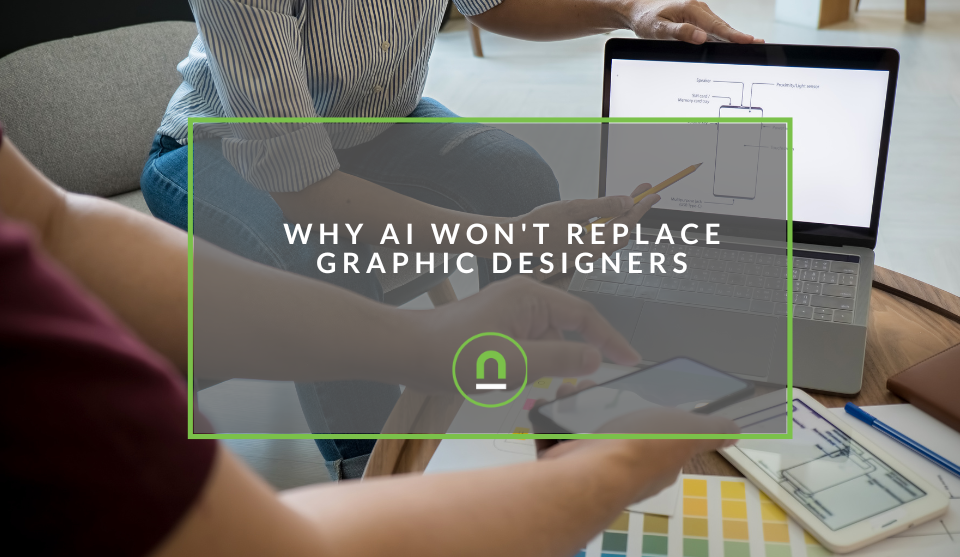Recent posts

nichemarket Advice
The South African VAT Threshold Chokehold
05 December 2025

Doctors Orders
The Difference Between SOAP Notes and DAP Notes
02 December 2025

Petrol heads
Why Load Bin Accessories Make Your Bakkie So Much Easier to Live With
26 November 2025

Alarming
What Is The Part Time Job WhatsApp Scam?
25 November 2025
Popular posts
Extravaganza
Trending Music Hashtags To Get Your Posts Noticed
24 August 2018
Geek Chic
How To Fix iPhone/iPad Only Charging In Certain Positions
05 July 2020
Extravaganza
Trending Wedding Hashtags To Get Your Posts Noticed
18 September 2018
Money Talks
How To Find Coupons & Vouchers Online In South Africa
28 March 2019
Why AI Won't Replace Graphic Designers
15 June 2025 | 0 comments | Posted by Che Kohler in Temping
The rise of AI-powered design tools has sparked widespread concern among graphic designers about job security. Headlines proclaim the imminent death of creative professions, and social media is flooded with AI-generated artwork that seems to challenge human creativity.
However, this narrative oversimplifies the complex relationship between artificial intelligence and graphic design.
There is some truth to these claims; when you consider how far AI image and video generation have come in the last two years, it's alarming, but these large leaps in quality will become smaller and less impressive over time.
As we reach the upper bound of what this technology can do and as users become accustomed to the limits of these tools, we will find an equilibrium of human versus AI designers.
Rather than eliminating design jobs, AI is creating new opportunities for savvy designers who understand how to leverage technology while capitalising on uniquely human strengths.
The Client Reality: Time Constraints Trump Tool Capabilities
Despite the impressive capabilities of modern AI design tools, there's a fundamental disconnect between what these tools can do and what most clients are willing or able to invest in learning them.
Business owners, marketing managers, and entrepreneurs didn't start their companies to become design experts—they have core businesses to run, strategies to develop, and customers to serve.
Learning to effectively use AI design tools requires a significant time investment. Users must understand prompt engineering, iterate through multiple generations, refine outputs, and develop an eye for what works and what doesn't. For a busy executive, this learning curve represents dozens of hours that could be spent on revenue-generating activities.
The opportunity cost of becoming proficient with AI design tools often far exceeds the cost of hiring a professional designer.
Moreover, clients often don't know what they want until they see it.
The iterative process of design—presenting concepts, gathering feedback, and refining based on that feedback—requires human communication skills and creative interpretation that AI tools, despite their sophistication, cannot fully replicate.
A designer serves not just as a creator but as a visual consultant who can translate abstract business goals into concrete design solutions.
AI Clears Out the Painful Clients
Taking on a career as a graphic designer or any freelancer will pit you against a specific type of client, the one that wants to pay the least, ask the most and critique everything you do.
These clients are often not worth the hours spent working with or trying to retain them, both in terms of monetary value and the toll on your sanity.
The cost-sensitive or difficult-to-deal-with clients will tend to move towards AI, as costs are fixed versus the amount of output they can produce. An AI will make any necessary adjustments they desire, with the output being all on them and no one else to blame.
With this type of clientele removed from the pool, you can focus on those who appreciate the efforts you make and the design principles you follow.
The Limitation Reality: AI Tools Have Boundaries
While AI design tools have made remarkable progress, they still face significant limitations that create opportunities for human designers. AI excels at generating variations on existing concepts but struggles with truly innovative thinking that breaks from established patterns. It can create beautiful individual pieces but often lacks the strategic thinking required for comprehensive brand systems.
Consistency across multiple touchpoints remains a challenge for AI tools. A logo might look perfect in isolation, but how does it work across business cards, websites, billboards, and social media?
AI tools often generate inconsistent styling, spacing, and proportional relationships when creating related materials. They may also struggle with technical requirements like print specifications, accessibility standards, and platform-specific constraints that professional designers navigate effortlessly.
Additionally, AI tools frequently produce designs that are aesthetically pleasing but strategically misaligned. They might create a beautiful layout that completely misses the target audience, fails to communicate the intended message, or ignores crucial brand positioning.
Human designers bring strategic thinking, market awareness, and communication expertise that transform pretty pictures into effective business tools.
The Template Management Advantage: Consistency and Efficiency
One of the most overlooked opportunities in the AI design era is template management and systematic design thinking. While AI can generate individual designs, maintaining consistency across a brand's ecosystem requires human oversight and strategic planning. Designers who position themselves as template creators and brand system managers become invaluable to clients who need ongoing design support.
Smart designers are creating comprehensive template libraries that clients can use for routine needs while maintaining brand consistency. These might include social media templates, presentation layouts, marketing materials, and document designs that follow established brand guidelines.
The designer's role evolves from creating every single piece to architecting systems that enable clients to create their own materials while ensuring professional quality and brand alignment.
This approach provides ongoing value to clients. Instead of starting from scratch for every design need, businesses can access professionally crafted templates that maintain brand consistency. When they need modifications or entirely new materials, they return to the designer who understands their brand system intimately. This creates a recurring relationship rather than transactional project work.
Template management also includes the crucial task of making small tweaks and adjustments. While AI might be able to generate a social media post, it often struggles with specific adjustments like changing text hierarchy, adjusting spacing, or adapting layouts for different platforms.
These "small" changes require design expertise and are often more time-consuming than clients expect.
Monetising Design Skills in the AI Era: Flexible Billing and Micro-Transactions
The evolution of design work in the AI era requires equally evolved business models. Traditional project-based billing, while still relevant for major initiatives, may not capture all the value designers provide in ongoing relationships. Smart designers are adopting flexible billing structures that better align with how clients actually consume design services.
Hourly billing works well for consultation, strategic planning, and complex problem-solving where the scope is uncertain. Project-based billing suits well-defined deliverables like logo design, website creation, or comprehensive brand development. However, the real opportunity lies in hybrid models that accommodate the ongoing, iterative nature of modern design needs.
Consider implementing a "design credit" system where clients purchase blocks of design time that can be used flexibly across different types of work. This might include template creation, minor adjustments, strategic consultation, or new project development. Credits could be priced differently based on the type of work—strategic consultation might consume credits faster than template modifications.
Revision-based billing addresses one of the most common client pain points: uncertainty about revision costs. Instead of unlimited revisions (which can be unprofitable) or strict revision limits (which can frustrate clients), consider offering revision packages. Clients might purchase three revisions with their initial project, with additional revisions available at predetermined rates.
Bitcoin and Lightning Network: Enabling True Micropayments
Another opportunity for human design monetisation lies in freelancing for cryptocurrency micropayments, particularly through Bitcoin's Lightning Network. Traditional payment systems make small transactions economically unfeasible due to processing fees, but Lightning Network enables instant, low-cost payments that could improve how design services are purchased and delivered.
Imagine a client needing a quick colour adjustment to a social media template. Instead of initiating a formal project with contracts and invoicing, they could instantly pay $5 via Lightning Network for a five-minute modification.
This frictionless payment system enables designers to monetise small services that were previously too costly to transact. Lightning Network payments could enable truly granular pricing models. A client might pay $2 for a colour scheme consultation, $8 for a logo modification, or $15 for a custom social media template. These micro-transactions aggregate into significant revenue streams while providing clients with exactly the services they need without over-purchasing.
The technology also enables innovative service models like design streaming, where clients pay small amounts for ongoing access to designer expertise, or pay-per-view design consultations, where clients can access recorded design advice for specific challenges. The low transaction costs make these models economically viable for both parties.
For international clients, Bitcoin payments eliminate currency conversion fees and banking delays, making small design services accessible to a global market.
A designer in New York could seamlessly serve clients in Argentina, Nigeria, or Thailand without worrying about payment processing challenges that typically make small international transactions impractical.
Building Your AI-Era Design Business
Success in the AI era requires designers to think beyond traditional service models and embrace technology as an enabler rather than a threat. Start by identifying which aspects of your work AI handles well and which remain uniquely human. Develop expertise in template systems, brand management, and strategic design thinking that provides ongoing value to clients.
Experiment with flexible pricing models that reflect the varied ways clients consume design services. Consider offering multiple engagement options: traditional project work for major initiatives, retainer relationships for ongoing support, and micropayment options for quick modifications and consultations.
Invest time in understanding Bitcoin payments, particularly Lightning Network, as early adoption could provide a significant competitive advantage. The ability to offer frictionless micropayments opens up service models that traditional payment systems cannot support.
Most importantly, focus on developing the uniquely human skills that AI cannot replicate: strategic thinking, client communication, brand understanding, and creative problem-solving. These capabilities, combined with smart use of AI tools and innovative business models, position designers for success in an evolving industry.
The Future is Collaborative, Not Competitive
AI won't eliminate graphic design jobs—it will transform them. Designers who understand this transformation and adapt their skills and business models accordingly will find more opportunities, not fewer. The key lies in embracing AI as a powerful tool while doubling down on the uniquely human elements of design work: strategy, communication, systems thinking, and creative problem-solving.
The future belongs to designers who can seamlessly blend AI capabilities with human insight, offer flexible engagement models that match how clients actually work, and leverage new payment technologies to monetise their expertise more effectively.
Rather than fearing AI, successful designers will utilise it to amplify their capabilities, focusing on the high-value work that only humans can provide.
In this new landscape, the most successful designers won't be those who can compete with AI on speed or volume, but those who can provide the strategic thinking, brand understanding, and communication skills that turn AI-generated content into effective business solutions. The opportunity is enormous for designers who are ready to evolve with technology rather than resist it.
Are you looking to promote your business?
Businesses and freelancers can create their own free business listings on nichemarket. The more information you provide about your business, the easier it will be for your customers to find you online.
Registering with nichemarket is easy; simply head over to our sign-up form and follow the instructions. If you require a more detailed guide on how to create your profile or listing, we highly recommend checking out the following articles.
Recommended reading
If you enjoyed this post and have time to spare, why not check out these related posts and dive deeper down the rabbit hole of remote work?
- As More Types of Work Go Online, More Workers Are Going Nomadic
- Why Blue Light Glasses Are A Must For Digital Nomads
- How To Find Tech Vacancies in South Africa
- How To Build Relationships With Remote Workers
- 8 Tips to Help You Make It Through Your First Year as a Freelancer
Tags: Freelancing, Gig Work
You might also like
48 Black Friday Software Deals 2025
14 November 2025
Posted by Che Kohler in Shopaholics
We put together a comprehensive list of software and digital business offering Black Friday discounts on their subscriptions or digital products this...
Read moreThe Difference Between SOAP Notes and DAP Notes
02 December 2025
Posted by Che Kohler in Doctors Orders
A look at SOAP format, which remains the classic choice for healthcare professionals, while DAP notes offer more flexibility for mental health docume...
Read more{{comment.sUserName}}
{{comment.iDayLastEdit}} day ago
{{comment.iDayLastEdit}} days ago
 {{blogcategory.sCategoryName}}
{{blogcategory.sCategoryName}}

